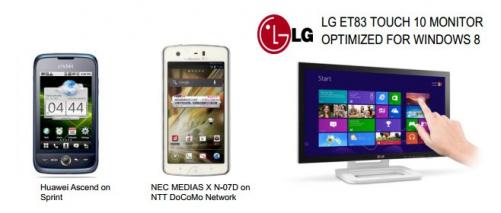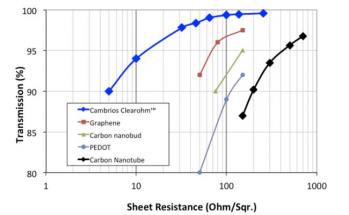Indium-Tin-Oxide (ITO) is currently used in OLED panels for the transparent cathode (or anode in top-emission OLEDs). ITO is useful because it is conductive and transparent, but its supply is limited (even though companies are now harvesting ITO from recycled electronics devices) and it's also brittle (so it's not suitable for flexible panels) and so companies are looking for alternatives.
 Some products that use Cambrios Ag-Wires
Some products that use Cambrios Ag-Wires
One possible alternative are silver wires (or ag-wire). This technology is pioneered by Cambrios - a company established in 2002 with an aim to commercialize Ag-Wire based products. Cambrios ClearOhm is a Ag-Wire coating material used to create transparent conductive layers. ClearOhm can be deposited on thin films using a roll-to-roll (R2R) process, and is compatible with plastic substrates. It's also possible to use a sheet process on glass or plastic. Cambrios has filed over 175 patents for this technology and they claim they hold basic ag-wire patents. My friend Sri Peruvemba recently joined the company to become its chief marketing officer and he was kind enough to discuss their technology with me and help me with this article.
Silver wires are currently mostly used to replace ITO in projected capacitance touch screens, used in phones and computer monitors. But obviously I'm more interested in OLED applications. Basically Cambrios claims that ClearOhm is cheaper and better than ITO for OLED electrodes (as it offers better transmission and better conductivity). As ClearOhm cathodes can be flexed (unlike ITO), it is more suitable for plastic based flexible OLEDs. It is also more suitable for laser-based patterning processes.
Currently I'm not aware of any commercial OLED display or lighting panel that actually use ClearOhm. It seems that the company is currently more focused on OLED lighting panels, developing the technology together with partners. In April 2010 Cambrios announced a partnership with Plextronics to develop a new OLED electrode material, and in December 2011 they two companies began to co-market this material for OLED lighting devices. A few weeks ago Novaled unveiled a new metal grid free 10x10 cm OLED lighting panel prototype that uses Cambrios silver nanowire ClearOhm transparent electrode material.

Of course Silver Nanowires isn't the only technology alternative for ITO. Companies are also looking at graphene (and graphene-based materials such as GraphenExeter), carbon nanotures and PEDOT (polymer based materials, which can be combined with OLEDs HIL for OLED lighting panels). Cambrios claims that their material offers superior performance and is cost-effective. They say that ClearOhm is the only ITO alternative that actually in commercial products and in mass production today.


Silver-ions is a big environment problem for all water-living organisms because of that the silver-ions
is toxic for water-living organisms.
Silver-ions have become something for eliminate bacterias but silver-ions eliminate even good bacterias.
It would be better to use organic graphite-based materials for conductors which also are transparent
like molybdenite or graphene which don't have this environmentelly problems like silver-ions is
for water-living organisms.